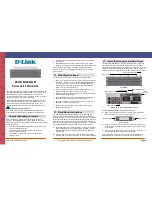
5 - 3
SONY SDT-10000/SDT-11000 DDS Tape Drive
5. SCSI INTERFACE
For implementation details on these commands, see the Command section.
The following Optional commands are NOT supported.
- CHANGE DEFINITION
- COMPARE
- COPY AND VERIFY
- 10 byte MODE SENSE & MODE SELECT
- READ REVERSE
- TRACK SELECT (SCSI-1 optional command, not applicable to the SDT-10000/SDT-11000)
5. 2 SCSI BUS OPERATION
5. 2. 1 Typical SCSI Operation
This example describes the typical SCSI bus sequence between the host and the drive.
1.
After waiting for the bus clear time the Host arbitrates for the SCSI bus. It does this by asserting BSY and the data
line corresponding to its bus ID. If any other devices wish to compete for the bus, they also assert BSY and the
appropriate data line. Each arbitrating device then inspects the data bus. The device with the highest ID wins the
bus. All the other devices must release BSY and their data lines.
2.
The Host attempts to select the target by asserting SEL and releasing BSY. The Host maintains its ID and asserts the
target’s ID on the data bus. Each target then checks the data lines. If the target’s ID matches that on the data bus, it
accepts selection by asserting BSY. Once the Host has detected BSY being asserted, it asserts ATN to indicate that
it wants the target to go to the MESSAGE OUT phase. The Host releases SEL.
3.
The target now has control of the SCSI bus and it is the target which switches between phases. The target responds
to the ATTENTION condition and initiates the MESSAGE OUT phase. The Host sends an IDENTIFY message
which tells the target which logical unit the Host wishes to talk to. The fact that the target responds to the ATN
indicates to the Host that the target can accommodate more than just a COMMAND COMPLETE message.
4.
The target initiates the COMMAND phase and transfers the Command Descriptor Block from the Host. In the
COMMAND phase, the target decodes the command and either executes the command (TEST UNIT READY) or
sets itself up for a data transfer to the Host (READ, WRITE, INQUIRY etc.). The target then either switches to the
STATUS phase, if the command is complete, or if it is ready to transfer data, the DATA phase.
5.
The data transfer length is set by the Host in the Command Descriptor Block. The target will remain in the DATA
phase until all the data is transferred.
6.
The target then initiates a STATUS phase and transfers one byte to the Host to indicate whether the target has
successfully completed the command. If the target has detected an error, the next command that the Host is ex-
pected to send is REQUEST SENSE. This allows the target to return further status information to the Host.
7.
The target completes the SCSI sequence by going to the MESSAGE IN phase and transferring a COMMAND
COMPLETE message to the Host. The target then releases BSY allowing the bus to go to the BUS FREE state.
5. 2. 2 Disconnect
In order to improve bus usage and performance, the unit is capable of temporarily disconnecting from the bus, conse-
quently allowing other initiator-target communications to take place. To do so, however, the Host needs to support
Disconnect/Reselect. The mechanism for performing the Disconnect/Reselect procedure is implemented as follows:
1.
The Host arbitrates for the SCSI bus and upon winning the bus it proceeds to select target device. Prior to releasing
SEL and completing the selection phase, the Host asserts the ATN line. The Host then releases SEL and BSY to
allow the target to assume control of the SCSI bus. By asserting ATN, the host indicates that the target should go to
a MESSAGE OUT phase.
Содержание DDS-4
Страница 177: ...3 866 308 03 ...
















































